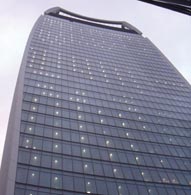Professional Security magazine editor Mark Rowe writes in the April 2015 print issue:
Last issue I should have corrected a wrongly captioned photo from the January issue. To illustrate the article about corporate security I said my picture was of the ‘Cheese Grater’ building in Leadenhall Street in the City of London; only I’d taken a photo of 20 Fenchurch Street, pictured. It goes to show when I last used a cheese grater.
People are entitled to be experts on the buildings they work in, or pass on the street. Some subjects, everybody feels an expert, or at least they feel confident about airing an opinion. Take football hooliganism for instance. Politicians, the media, get agitated about it, and the violence and hatred spouted at football matches – I’m talking about the spectators, by the way – is no different to what door staff have to put up with on a Friday and Saturday night. Indeed, the violence is probably by some of the same men. It could be that hooliganism in sports stadia is visible and photographed and punch-ups at nightclubs are not. Without pointing fingers (which would be bad conflict management in any case), I have rounded up the latest incidents (page 28). What’s the reason – less policing, complacency, particular events at each ground, fans generally feeling angry and left out? What’s intriguing, having watched the Aston Villa fans take the field as their team won the FA Cup quarter-final last month – you see I’m an expert too, thanks to the TV – was that judging by their faces, most were simply pleased their team won and meant no harm. But if you were a million-pound footballer and had scores of blokes running towards you, you’d be right to feel afraid – simply in case a friendly fan broke a bone in a collision.
It’s too many years since I covered crime science properly – and younger readers may sadly have never heard of Jill Dando, the TV presenter who gave her name to the University College London centre of ‘crime science’. Hence I took in half a day of a crime intelligence conference in Manchester (page 44), and heard from one of the authorities on the subject, Prof Gloria Laycock. She also trailed the ‘What Works’ website (page 40). Crime mapping, so that you send patrols when and where the reported crime happens, can save money and catch criminals. However as ever it’s only as good as the software. I heard from a West Midlands Police analyst that the average (‘mean positional error’) difference between where a crime such as a robbery happened and where the software placed it on a grid was 192m – perhaps two football pitches long. That’s not the fault of the staff plotting the reported crime, but the software not allowing humans to plot it accurately. Is that annoying, or reassuring?









